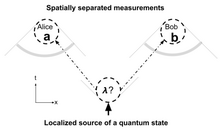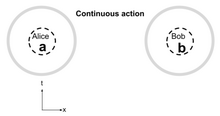Principle of locality
The principle of locality plays a critical role in one of the central results of quantum mechanics.In 1935, Albert Einstein, Boris Podolsky, and Nathan Rosen, with their EPR paradox thought experiment, raised the possibility that quantum mechanics might not be a complete theory.They described two systems physically separated after interacting; this pair would be called entangled in modern terminology.They reasoned that without additions, now called hidden variables, quantum mechanics would predict illogical relationships between the physically separated measurements.[1]Coulomb's law of electric forces was initially also formulated as instantaneous action at a distance, but in 1880, James Clerk Maxwell showed that field equations – which obey locality – predict all of the phenomena of electromagnetism.He later succeeded in producing an alternative theory of gravitation, general relativity, which obeys the principle of locality.However, a different challenge to the principle of locality developed subsequently from the theory of quantum mechanics, which Einstein himself had helped to create.The gray ring indicates events from all parts of space and time can affect the probability measured by Alice or Bob.So in the case of continuous action, events at all times and places affect Alice's and Bob's model.This simple model is highly successful for solar planetary dynamics with Newtonian gravity and in electrostatics, cases where relativistic effects are insignificant.Inputs from the future (above the dashed line) are no longer considered part of Alice's or Bob's model.[2] Common sense arguments about the future not affecting the present are reasonable criteria but such assumptions alter the mathematical character of the models.[5] In their view, the classical principle of locality implied that "no real change can take place" at Bob's site as a result of whatever measurements Alice was doing.Other physicists did not agree: they accepted the quantum wavefunction as complete and questioned the nature of locality and reality assumed in the EPR paper.Subsequent experimental tests have shown that some quantum effects do violate Bell's inequalities and cannot be reproduced by a local hidden-variables theory.Bell described local causality in terms of probability needed for analysis of quantum mechanics.If local causality holds, then the probabilities observed by Alice and by Bob should be only coupled by the hidden variables, and we can show that[7][8] The 2022 Nobel Prize in Physics was awarded to Alain Aspect, John Clauser and Anton Zeilinger, in part "for experiments with entangled photons, establishing the violation of Bell inequalities".[12]This definition includes classical concepts like "well-defined", which conflicts with quantum superposition, and "prior to ... measurements", which implies (metaphysical) preexistence of properties.[11]: 98 Consequently, Bell's theorem does not restrict the possibility of nonlocal variables as well as theories based on retrocausality or superdeterminism.[2] Because of the probabilistic nature of wave function collapse, this apparent violation of locality in quantum mechanics cannot be used to transmit information faster than light, in accordance to the no communication theorem.[13] Asher Peres distinguishes between weak and strong nonlocality, the latter referring to the theories that allow faster-than-light communication.This condition can be achieved by avoiding terms in the Lagrangian that are products of two fields that depend on distant coordinates.




Localityphysicsaction at a distancefield theoriesclassical physicsspecial theory of relativityspeed of lightAlbert EinsteinBoris PodolskyNathan RosenEPR paradoxquantum mechanicsentangledhidden variablesJohn Stewart BellBell's theoremlocal hidden variablesBell testinterpretations of quantum mechanicsuniversal gravitationBentleyCoulomb's lawJames Clerk Maxwell field equationsgeneral relativityspacetime diagramsparticle-like or wave-like resultsprobabilitycorrelationEinstein–Podolsky–Rosen paradoxquantum entanglementwavefunction collapseBell's inequalitiesNobel Prize in PhysicsAlain AspectJohn ClauserAnton ZeilingerQuantum nonlocalityquantum superpositionretrocausalitysuperdeterminisminformationno communication theoremAsher Peresquantum field theoryfield operatorsLagrangian densityobservablesspacelikecommuteEinstein's thought experimentsLocal hidden-variable theoryNon-locality (disambiguation)Cluster decompositionCounterfactual definitenessBibcodeFeynman, Richard P.Leighton, Robert B.Sands, Matthew L.The Feynman Lectures on PhysicsNobel FoundationH. Dieter Zeh